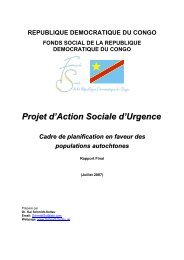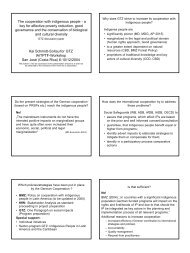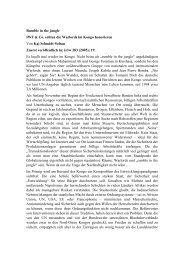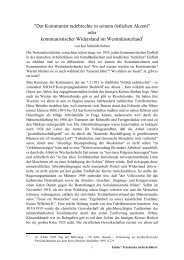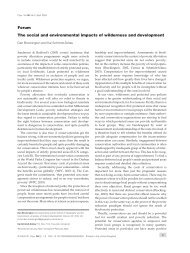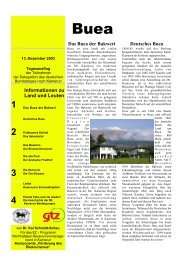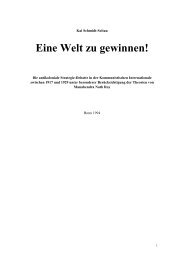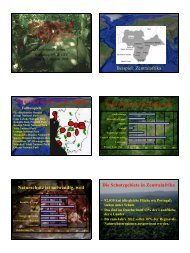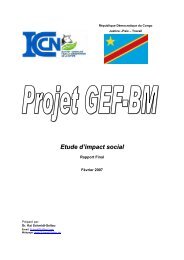Cadre Procédural de Réinstallation - Dr. Kai Schmidt-Soltau
Cadre Procédural de Réinstallation - Dr. Kai Schmidt-Soltau
Cadre Procédural de Réinstallation - Dr. Kai Schmidt-Soltau
Create successful ePaper yourself
Turn your PDF publications into a flip-book with our unique Google optimized e-Paper software.
ICCN<br />
<strong>Cadre</strong> procédural <strong>de</strong> Réinstallation du Projet GEF-BM<br />
Executive Summary<br />
In the context of state restructuring and rehabilitation, the Democratic Republic of Congo (DRC) has<br />
put in place a comprehensive reform agenda in the area of natural resource management. The New<br />
Vision for the conservation of protected areas in the DRC (2003) foresees “an effective and well<br />
coordinated management of a network of protected areas to make sure that biodiversity conservation<br />
is an integral part of the National Forest and Biodiversity Programme and the national Poverty<br />
Reduction Strategy”. For the implementation of this new vision the government of DRC has requested<br />
financial assistance from the Global Environmental Facility (GEF) through the World Bank (WB). The<br />
GEF-WB Project consists of three components:<br />
Component 1: Support to ICCN institutional rehabilitation (national level);<br />
Component 2: Support to selected key national parks (site level);<br />
Component 3: Evaluation and expansion of the protected areas network (national level).<br />
The GEF-WB Project might impact on rural populations through the i<strong>de</strong>ntification of new protected areas<br />
with a total surface area of 10 Million ha, through the establishment of new protected areas with a total<br />
surface area of 2 Million ha and the enhancement of management in two national parks (Virunga and<br />
Garamba), which have a total surface area of 1.3 Million ha. Overall, the GEF-WB Project might impact<br />
on 15.8 Million people. One direct impact of the GEF-WB project on the people living insi<strong>de</strong> and outsi<strong>de</strong><br />
the existing and proposed protected areas will be the physical and economic displacement <strong>de</strong>spite the<br />
fact, that the GEF-WB Project will not finance any resettlement-related activity. This impact arises from<br />
the enhancement of the protection status, the enforcement of laws and regulation in protected areas and<br />
their buffer zones and the conversion of unprotected forests into protected areas. All this certainly<br />
reduces the access of the rural population to the natural resources in these areas and causes a loss of<br />
benefits, which arises from more economic forms of land use (forestry exploitations, plantations, mines<br />
etc.). In line with the best practice (the Operational Policy on Involuntary Resettlement of the World<br />
Bank; OP 4.12) the GEF-WB Project has to address these problems and find mutual and timely solutions<br />
before implementation. Those categories of project affected people (PAP) marked green in the table are<br />
those addressed in the context of this Resettlement Process Framework (RPrF).<br />
National Park (NP) & other protected area (PA)<br />
Buffer zones (50 km outsi<strong>de</strong> PA)<br />
Site Surface (km²) PAP Density Surface (km²) PAP Density<br />
Virunga NP (PNVi) 7.900 150.000 19 31.510 9.453.000 300<br />
Garamba NP (PNG) 4.920 0 0 7.527 170.054 22,6<br />
Total 12.820 150.000 39.037 9.623.054<br />
New PA 20.000 460.000 23 52.922 1.217.206 23<br />
I<strong>de</strong>ntification of PA 100.000 2.300.000 23 163.886 3.769.378 23<br />
Total 112.820 2.450.000 202.923 13.392.432<br />
This study has been carried out by the Institut Congolais pour la Conservation <strong>de</strong> la Nature (ICCN)<br />
with the assistance of an international consultant. Within the preparation cycle of the GEF-WB Project,<br />
it verifies whether the project fulfils the social safeguard standards of the World Bank in view of a<br />
possible financial engagement and prescribes mitigation measures to ensure compliance. The report<br />
presents the findings of a short term consultancy carried out in a participatory manner and in close<br />
cooperation with all stakehol<strong>de</strong>rs (ICCN, rural populations, NGOs, governmental services, donors<br />
etc.).The report has been discussed on three workshops (Nagero 18/12/2006, Kinshasa 10/1/2007 & Beni<br />
13/1/2007) and consequently adopted by all stakehol<strong>de</strong>rs.<br />
The OP 4.12 foresees the elaboration of a Resettlement Process Framework (RPrF) to mitigate the<br />
economic displacement – the involuntary restriction of access to land and resources – of those people<br />
who live in the buffer zones of the PNVi and PNG - marked green in the table - and those who continue<br />
to live insi<strong>de</strong> the parks during and after project implementation. For now it is to early to specify how many<br />
people will be able to continue to live officially in the national parks as the management plans, which<br />
might allow this in view to avoid the physical displacement, are not yet available.<br />
The RPrF is prepared in accordance with the Resettlement Policy Framework (RPoF) of the GEF-WB<br />
Project, which provi<strong>de</strong>s the guiding principles and outlines measures to compensate the other<br />
categories of people in the table. The two reports ensure that all people affected by the GEF-WB<br />
Project are assisted in their efforts to improve their livelihoods and standards of living or at least to<br />
restore them to pre-displacement levels. The impacts of the GEF-WB Project on lands and livelihoods<br />
are treated in line with the 2006 Constitution and relevant laws of the DRC and the OP 4.12. As the<br />
conservation laws of the DRC are outdated and presently in a revision process, the later should be<br />
applied in cases where there are differences between the national and international standards.<br />
Rapport Final Février 2007 8




